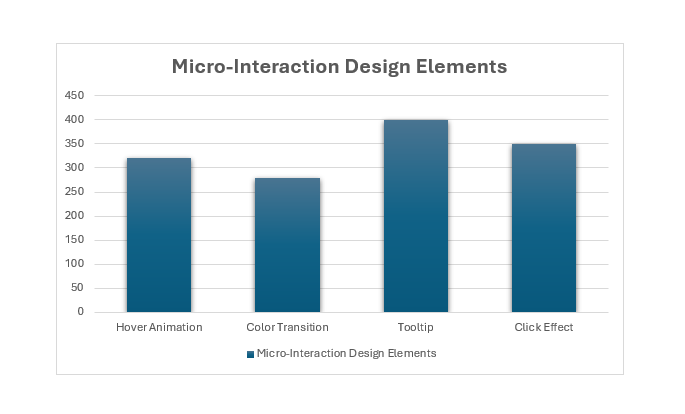Surveying the Impact of Rarely Investigated Design Components on User Engagement
DOI:
https://doi.org/10.51903/ijgd.v3i1.2752Keywords:
user engagement, micro-interactions, transition effects, haptic feedback, UI/UX designAbstract
The rise of social media has transformed digital interaction, making user engagement a critical metric for platform success. While much research has examined conventional design elements such as layout and typography, the influence of rarely studied micro-design components remains underexplored. This study investigates the impact of micro-interactions, transition effects, and haptic feedback on user engagement. Using a quantitative survey method, data were collected from 400 active social media users who spend at least five hours weekly on digital platforms. The research employed a Likert-scale questionnaire combined with platform analytics to assess perceived usability and actual behavioral metrics. Results show that 73.5% of respondents experienced increased engagement through micro-interactions, while 68.2% found transition effects beneficial for smoother navigation. Although haptic feedback received less preference (56.8%), it enhanced multisensory interaction, especially among mobile users. Statistically, these components contributed to a 15.8% increase in session duration and significant improvements in engagement metrics—likes (25.4%), comments (47.6%), and content shares (66.7%). Regression and factor analysis confirmed the positive influence of all three design variables. This study contributes to the field of UI/UX by highlighting how overlooked micro-design elements can shape user behavior and improve platform interaction quality. The findings offer practical guidance for designers and developers to enhance user experience through subtle yet impactful interface innovations. Future research should explore adaptive and AI-driven design features to further personalize digital engagement.
References
Akin, M. S. (2024). Enhancing e-commerce competitiveness: A comprehensive analysis of customer experiences and strategies in the Turkish market. Journal of Open Innovation: Technology, Market, and Complexity, 10(1), 100222. https://doi.org/10.1016/j.joitmc.2024.100222
Avila-Munoz, R., Clemente-Mediavilla, J., & Perez-Luque, M. J. (2021). Communicative functions in human-computer Interface design: A taxonomy of functional animation. Rcommunicationr.Org, 9, 119–146. https://doi.org/10.12840/issn.2255-4165.030
Bitrián, P., Buil, I., & Catalán, S. (2021). Enhancing user engagement: The role of gamification in mobile apps. Journal of Business Research, 132, 170–185. https://doi.org/10.1016/j.jbusres.2021.04.028
Castro-Alonso, J. C., de Koning, B. B., Fiorella, L., & Paas, F. (2021). Five Strategies for Optimizing Instructional Materials: Instructor- and Learner-Managed Cognitive Load. Educational Psychology Review 2021 33:4, 33(4), 1379–1407. https://doi.org/10.1007/s10648-021-09606-9
Ceccacci, S., Generosi, A., Leopardi, A., Mengoni, M., & Mandorli, F. (2021). The Role of Haptic Feedback and Gamification in Virtual Museum Systems. Journal on Computing and Cultural Heritage (JOCCH), 14(3). https://doi.org/10.1145/3453074
Chen, C., Li, C., Lu, K., Chen, H., Xiao, X., & Fang, C. (2024). Study on Multiscale Virtual Environment Construction and Spatial Navigation Based on Hierarchical Structure. ISPRS International Journal of Geo-Information 2024, Vol. 13, Page 219, 13(7), 219. https://doi.org/10.3390/ijgi13070219
Chen, L.-B., Huang, T.-H., See, A. R., Antonio, J., Choco, G., & Chandramohan, K. (2022). Touch, Texture and Haptic Feedback: A Review on How We Feel the World around Us. Applied Sciences 2022, Vol. 12, Page 4686, 12(9), 4686. https://doi.org/10.3390/app12094686
Chen, S. H., Kuo, Y., & Lin, J. K. (2020). Using Mahalanobis distance and decision tree to analyze abnormal patterns of behavior in a maintenance outsourcing process-a case study. Journal of Quality in Maintenance Engineering, 27(2), 253–263. https://doi.org/10.1108/jqme-04-2019-0037
Dağ, K., Çavuşoğlu, S., & Durmaz, Y. (2024). The effect of immersive experience, user engagement and perceived authenticity on place satisfaction in the context of augmented reality. Library Hi Tech, 42(4), 1331–1346. https://doi.org/10.1108/lht-10-2022-0498
Dwivedi, Y. K., Ismagilova, E., Hughes, D. L., Carlson, J., Filieri, R., Jacobson, J., Jain, V., Karjaluoto, H., Kefi, H., Krishen, A. S., Kumar, V., Rahman, M. M., Raman, R., Rauschnabel, P. A., Rowley, J., Salo, J., Tran, G. A., & Wang, Y. (2021). Setting the future of digital and social media marketing research: Perspectives and research propositions. International Journal of Information Management, 59, 102168. https://doi.org/10.1016/j.ijinfomgt.2020.102168
Emami, M., Bayat, A., Tafazolli, R., & Quddus, A. (2024). A Survey on Haptics: Communication, Sensing and Feedback. IEEE Communications Surveys and Tutorials. https://doi.org/10.1109/comst.2024.3444051
Fiandini, M., Nandiyanto, A. B. D., Husaeni, D. F. Al, Husaeni, D. N. Al, & Mushiban, M. (2024). How to Calculate Statistics for Significant Difference Test Using SPSS: Understanding Students Comprehension on the Concept of Steam Engines as Power Plant. Indonesian Journal of Science and Technology, 9(1), 45–108. https://ejournal.kjpupi.id/index.php/ijost/article/view/348
Geng, S., Yang, P., Gao, Y., Tan, Y., & Yang, C. (2021). The effects of ad social and personal relevance on consumer ad engagement on social media: The moderating role of platform trust. Computers in Human Behavior, 122, 106834. https://doi.org/10.1016/j.chb.2021.106834
Gill, A., Irwin, D., Sun, L., Towey, D., Zhang, G., & Zhang, Y. (2025). Microlearning in Immersive Virtual Reality: A User-Centered Analysis of Learning Interfaces. IEEE Transactions on Learning Technologies. https://doi.org/10.1109/tlt.2025.3533360
Goretzko, D., Pham, T. T. H., & Bühner, M. (2021). Exploratory factor analysis: Current use, methodological developments and recommendations for good practice. Current Psychology, 40(7), 3510–3521. https://doi.org/10.1007/s12144-019-00300-2
Hsieh, S. H., Lee, C. T., & Tseng, T. H. (2022). Psychological empowerment and user satisfaction: Investigating the influences of online brand community participation. Information & Management, 59(1), 103570. https://doi.org/10.1016/j.im.2021.103570
Jiang, L., & Chen, Y. H. (2022). Menu Design on Small Display User Interfaces: Measuring the Influence of Menu Type, Number of Preview Items, and Menu Breadth on Navigation Efficiency. International Journal of Human–Computer Interaction, 38(7), 631–645. https://doi.org/10.1080/10447318.2021.1954781
Kwok, T. C. K., Kiefer, P., & Raubal, M. (2024). Unobtrusive interaction: a systematic literature review and expert survey. Human–Computer Interaction, 39(5–6), 380–416. https://doi.org/10.1080/07370024.2022.2162404
Lee, Y. M., Jahnke, I., & Austin, L. (2021). Mobile microlearning design and effects on learning efficacy and learner experience. Educational Technology Research and Development, 69(2), 885–915. https://doi.org/10.1007/s11423-020-09931-w
Li, W., Zhou, Y., Luo, S., & Dong, Y. (2022). Design Factors to Improve the Consistency and Sustainable User Experience of Responsive Interface Design. Sustainability 2022, Vol. 14, Page 9131, 14(15), 9131. https://doi.org/10.3390/su14159131
Lim, W. M., & Rasul, T. (2022). Customer engagement and social media: Revisiting the past to inform the future. Journal of Business Research, 148, 325–342. https://doi.org/10.1016/j.jbusres.2022.04.068
Liu, W., Cao, Y., & Proctor, R. W. (2021). How do app icon color and border shape influence visual search efficiency and user experience? Evidence from an eye-tracking study. International Journal of Industrial Ergonomics, 84, 103160. https://doi.org/10.1016/j.ergon.2021.103160
Liu, Z. (2024). Evaluating Digitalized Visualization Interfaces: Integrating Visual Design Elements and Analytic Hierarchy Process. International Journal of Human–Computer Interaction. https://doi.org/10.1080/10447318.2024.2365454
Lun, L., Zetian, D., Hoe, T. W., Juan, X., Jiaxin, D., & Fulai, W. (2024). Factors Influencing User Intentions on Interactive Websites: Insights from the Technology Acceptance Model. IEEE Access. https://doi.org/10.1109/access.2024.3437418
Makri, A., Vlachopoulos, D., & Martina, R. A. (2021). Digital Escape Rooms as Innovative Pedagogical Tools in Education: A Systematic Literature Review. Sustainability 2021, Vol. 13, Page 4587, 13(8), 4587. https://doi.org/10.3390/su13084587
Miraz, M. H., Ali, M., & Excell, P. S. (2021). Adaptive user interfaces and universal usability through plasticity of user interface design. Computer Science Review, 40, 100363. https://doi.org/10.1016/j.cosrev.2021.100363
Muñoz, R. Á., Mediavilla, J. C., & Pérez-Luque, M. J. (2023). Principles of Functional Animation in Interface Design. New Design Ideas, 7(2). https://sciencevalue.udit.es/articulos_cientificos/61
Nah, K., Oh, S., Han, B., Kim, H., & Lee, A. (2022). A Study on the User Experience to Improve Immersion as a Digital Human in Lifestyle Content. Applied Sciences 2022, Vol. 12, Page 12467, 12(23), 12467. https://doi.org/10.3390/app122312467
Nazir, S., Khadim, S., Ali Asadullah, M., & Syed, N. (2023). Exploring the influence of artificial intelligence technology on consumer repurchase intention: The mediation and moderation approach. Technology in Society, 72, 102190. https://doi.org/10.1016/j.techsoc.2022.102190
Odushegun, L. (2023). Aesthetic semantics: Affect rating of atomic visual web aesthetics for use in affective user experience design. International Journal of Human-Computer Studies, 171, 102978. https://doi.org/10.1016/j.ijhcs.2022.102978
Pardini, S., Gabrielli, S., Dianti, M., Novara, C., Zucco, G. M., Mich, O., & Forti, S. (2022). The Role of Personalization in the User Experience, Preferences and Engagement with Virtual Reality Environments for Relaxation. International Journal of Environmental Research and Public Health 2022, Vol. 19, Page 7237, 19(12), 7237. https://doi.org/10.3390/ijerph19127237
Pribićević, I., & Delibašić, B. (2021). Critical sustainability indicators identification and cause–effect relationships analysis for sustainable organization strategy based on fuzzy DEMATEL. Environment, Development and Sustainability, 23(12), 17263–17304. https://doi.org/10.1007/s10668-021-01360-w
Prihatmoko, S., & Setiyadi, T. (2024). Enhancing Public Awareness of the Designer Profession: Visual Communication Strategies in Instagram Campaigns. International Journal of Graphic Design, 2(2), 179–194. https://doi.org/10.51903/ijgd.v2i2.2113
Purhita, E. J., & Rudjiono, D. (2024). Evaluating the Effectiveness of Interactive Multimedia in Boosting Brand Equity: A Case Study of Visual Communication Design Programs. International Journal of Graphic Design, 2(2), 144–160. https://doi.org/10.51903/ijgd.v2i2.2109
Qalati, S. A., Yuan, L. W., Khan, M. A. S., & Anwar, F. (2021). A mediated model on the adoption of social media and SMEs’ performance in developing countries. Technology in Society, 64, 101513. https://doi.org/10.1016/j.techsoc.2020.101513
Schreiber, J. B. (2021). Issues and recommendations for exploratory factor analysis and principal component analysis. Research in Social and Administrative Pharmacy, 17(5), 1004–1011. https://doi.org/10.1016/j.sapharm.2020.07.027
Schreiner, M., Fischer, T., & Riedl, R. (2021). Impact of content characteristics and emotion on behavioral engagement in social media: literature review and research agenda. Electronic Commerce Research, 21(2), 329–345. https://doi.org/10.1007/s10660-019-09353-8
Sharma, H. (2021). Statistical significance or clinical significance? A researcher’s dilemma for appropriate interpretation of research results. Saudi Journal of Anaesthesia, 15(4), 431–434. https://doi.org/10.4103/sja.sja_158_21
Smyth, J. M., Jones, D. R., Wen, C. K. F., Materia, F. T., Schneider, S., & Stone, A. (2021). Influence of ecological momentary assessment study design features on reported willingness to participate and perceptions of potential research studies: an experimental study. BMJ Open, 11(7), e049154. https://doi.org/10.1136/bmjopen-2021-049154
Stige, Å., Zamani, E. D., Mikalef, P., & Zhu, Y. (2024). Artificial intelligence (AI) for user experience (UX) design: a systematic literature review and future research agenda. Information Technology and People, 37(6), 2324–2352. https://doi.org/10.1108/itp-07-2022-0519
Tan, Y., Geng, S., Katsumata, S., & Xiong, X. (2021). The effects of ad heuristic and systematic cues on consumer brand awareness and purchase intention: Investigating the bias effect of heuristic information processing. Journal of Retailing and Consumer Services, 63, 102696. https://doi.org/10.1016/j.jretconser.2021.102696
Wallace, S., Bylinskii, Z., Dobres, J., Kerr, B., Berlow, S., Treitman, R., Kumawat, N., Arpin, K., Miller, D. B., Huang, J., & Sawyer, B. D. (2022). Towards Individuated Reading Experiences: Different Fonts Increase Reading Speed for Different Individuals. ACM Transactions on Computer-Human Interaction, 29(4). https://doi.org/10.1145/3502222
Wu, D., Xu, J. (David), & Abdinnour, S. (2022). Tablets for problem-solving through a flow theory: the impact of navigation and visual appearance on perceived performance and efficiency. Information Technology and People, 35(1), 142–164. https://doi.org/10.1108/itp-07-2019-0323

Downloads
Published
Issue
Section
License
Copyright (c) 2025 International Journal of Graphic Design

This work is licensed under a Creative Commons Attribution-ShareAlike 4.0 International License.
This work is licensed under a Creative Commons Attribution-ShareAlike 4.0 International License (CC BY-SA 4.0).
This license allows others to copy, distribute, display, and perform the work, and derivative works based upon it, for both commercial and non-commercial purposes, as long as they credit the original author(s) and license their new creations under identical terms.
Licensed under CC BY-SA 4.0: https://creativecommons.org/licenses/by-sa/4.0/











5.png)

